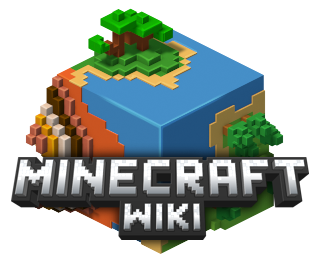เหตุผล: เพิ่มเติมเนื้อหา 1.18 และ 1.19 รวมทั้งแปลเนื้อหาทั้งหมด

แม่น้ำที่ไหล่ผ่านป่าดงดิบ

แม่น้ำที่ไหล่ผ่านไบโอมที่ราบสูงแบดแลน หรือ ไบโอม “ภูเขายอดราบ” ที่มี ทุ่งหญ้าสะวันนาอยู่บริเวณขวาล่าง

มหาสมุทรอุ่นที่สามารถมองเห็นแนวปะกาลังได้ในระยะ
| “ | หากคุณไม่ทราบว่า “ไบโอม” คืออะไร – ไบโอมก็คือเขตแบ่งภูมิอากาศซึ่งใช้ในเกมเพื่อกำหนดว่าพื้นที่นั้น ๆ ควรมีพื้นผิวอย่างไร (เช่น ทรายหรือหญ้า) ควรจะมีฝนตกหรือหิมะตก ควรจะมีพืชชนิดใดขึ้นบ้าง และบางครั้งก็หมายถึงสัตว์บางชนิดด้วย | „ | |
| — Jens Bergensten[1] |
ไบโอม (biome – แปลว่า ระบบนิเวศ, ชีวนิเวศ) เป็นภูมิภาคในโลกของ Minecraft ที่มีความแตกต่างกันในด้านภูมิศาสตร์ พืช ความสูง อุณหภูมิ อัตราความชื้น และสีของท้องฟ้าและใบไม้ ไบโอมสร้างสภาพแวดล้อมที่แตกต่างกันในทุก ๆ การเกิดของโลก เช่น ป่า (forest) ป่าดงดิบ (jungle) ทะเลทราย (desert) และไทกา (taiga) เป็นต้น
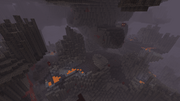
สันดอนหินบะซอลต์ ที่สามารถพบได้ในเนเธอร์
อุณหภูมิ[]

อุณหภูมิมีผลต่อโทนสีเขียวของหญ้าและโทนสีฟ้าของน้ำ
ไบโอมจะมีค่าอุณหภูมิเป็นของตัวเอง ซึ่งค่าอุณหภูมิจะเป็นตัวกำหนดว่าหยาดน้ำฟ้าที่จะตกลงมาจะเป็นฝน หรือหิมะ หรือไม่ทั้งสอง ซึ่งหากค่ามีค่าน้อยกว่า 0.15 หิมะจะตก, 0.15 – 0.95 ฝนจะตก, หรือมากที่สุดคือ 1 สำหรับเนเธอร์ โดยค่าเหล่านี้สามารถใช้ในการกำหนดความสูงของหิมะที่ตกในไบโอมนั้นอีกด้วย อุณหภุมิยังจะลดลงที่ 0.0016 (1⁄625) ต่อเมตรจากระดับน้ำทะเล (Y=64), แต่จะไม่เปลี่ยนแปลงหากอยู่ต่ำกว่าระดับของน้ำทะเล ยกตัวอย่างเช่น ภูเขา จะเกิดหิมะที่ระดับความสูง Y=95, เนื่องจากสภาพภูมิอากาศที่สูง ที่มีค่าอุณหภูมิ 0.2 โดยอุณหภูมิจะส่งผลต่อการตกของหยาดน้ำฟ้าเท่านั้น ในไบโอมแห้งแล้งต่างๆ จะไม่มีหยาดน้ำฟ้าใดๆเลย ยกตัวอย่างเช่น สะวันน่า จะไม่สามารถพบเห็นฝนตกได้เนื่องจากอุณหภูมิที่สูง
ไบโอมสามารถแบ่งได้ออกเป็น 5 ชนิดหากใช้เกณฑ์อุณหภูมิเป็นตัวแบ่ง ซึ่งได้แก่: หิมะปกคลุม, หนาว, เย็น/เขียวชะอุ่ม, แห้ง/อุ่น, และปานกลาง โดยพวกเขามักจะแยกออกจากกัน เพื่อป้องกันไบโอมที่มีความแตกต่างของอุณหภูมิสูงมาอยู่ติดกัน (เช่นไทกาหิมะอยู่ติดกลับทะเลทราย), และให้ไบโอมที่มีอุณหภูมิใกล้เคียงกันมาอยู่ไกล้กัน(เช่นป่า อยู่ติดกลับหนองบึง)
การเกิด[]
การเกิดของไบโอมจะแบ่งได้ของรุ่น 1.7 และรุ่นปัจจุบันนั้นจะแตกต่างกันในบางเรื่อง โดยทั่วไปแล้ว ไบโอมบกจะเกิดในกลุ่มก้อน 3 รูปแบบที่แตกต่างกัน ได้แก่ไบโอมหนาวเย็น, แห้งแลัง และสีเขียว โดยไบโอมสีเขียวนั้นมักจะใหญ่กว่าและมีความต่อเนื่องมากกว่า ส่วนไบโอมแห้งแล้ง และไบโอมหนาวเย็นจะเกิดเป็นกลุ่มก้อนเล็กๆ แต่ก็ยังสามารถขยายออกไปเป็นพันๆ บล็อกได้ ไบโอมหนาวเย็นประกอบด้วยไบโอมที่มีหิมะปกคลุมต่างๆ เช่นไบโอมไทกาหิมะ และไบโอมทุนดราหิมะเป็นต้น ส่วนไบโอมแห้งแล้งก็ประกอบด้วยสะวันนาแบบต่างๆ, ที่ราบบางชนิด และทะเลทราย ส่วนไบโอมสีเขียวประกอบด้วยไบโอมหนองบึง ที่ราบบางชนิด ป่าสีเข้ม ป่าเบิร์ช ป่า และภูเขาแบบต่างๆ ไบโอมที่ราบนั้นจะคาบเกี่ยวอยู่ระหว่างไบโอมสีเขียว และไบโอมแห้งแล้ง
อย่างไรก็ตามในแหล่งโค้ดของเกม ไบโอมสีเขียวนั้นยังสามารถแบ่งออกเป็นไบโอมสีเขียวปานกลาง และไบโอมสีเขียวชะอุ่ม โดยไบโอมสีเขียวปานกลางนั้นจะประกอบด้วยภูเขาบางชยนิด ไทกา ป่าบางชนิด และที่ราบบางชนิด ส่วนไบโอมสีเขียวชะอุ่มนั้นจะประกอบด้วยป่าเบิร์ช ป่าสีเข้ม ป่าบางชนิด หนองบึง และภูเขาบางชนิด วิธีเดียวที่จะแยกความแตกต่างของสองไบโอมนี้คือ ภูมิอากาศของของพื้นที่ไทกา กับป่าเบิร์ช ป่ามืดและหนองน้ำ ส่วนสภาพอากาศของป่าทั่วไป ภูเขาแบบต่างๆ และที่ราบจะดูธรรมดา จนผูเล่นอาจไม่ทันสังเกจถึงไบโอมสีเขียวทั้งสองนั้นมีความแตกต่างกัน
In snowy climates, Snowy Tundra are weighed 3 times more versus Snowy Taiga, meaning Snowy Taiga is much rarer than Snowy Tundra in snowy climates. In dry climates, Deserts are weighed 3 times, Savanna 2 times, and Plains only once, meaning in dry climates, Deserts are more likely than Savannas, but Plains are rarer than Savannas, within dry climates.
Plains biomes can overwrite Swamps if Swamps border snowy areas or Deserts. Jungle Edges overwrite Swamps if Jungles border Swamps. If Snowy Tundra borders Deserts, a Wooded Mountains biome will overwrite the Snowy Tundra.
Taigas that surround Giant Tree Taigas are generated in the Biome-Edge layer stage, however Jungle Edges and Deserts that surround Jungles and Badlands are generated in the stage where shores and beaches are generated.
Snowy, Temperate Green, Lush Green, and dry biome clusters, as well as Mushroom Fields, Jungles, Giant Tree Taigas, Oceans and Deep Oceans, are generated and pre-determined in the biome climate stage of biome generation. The biome clusters then generate their respective biomes.
Four land biomes are rarer, Mushroom Fields generate in Ocean biomes, Badlands in dry biomes, and Jungle and Giant Tree Taiga generate in green biomes. However, Giant Tree Taiga, Jungles, and Badlands tend to be expansive due to the rarity, and as such their variants are even more rare. These three land biomes may occasionally generate standalone separate from their parent biome clusters. In addition, an "edge" biome surrounds these three biomes. Jungle Edges separate Jungles from most other land biomes aside from regular Forest or Taiga (if bordering a Swamp the Jungle edge extends up to 3 chunks), and Desert separates Badlands from the rest of the land biomes except with Modified Badlands. Taiga and its variants surround Giant Tree Taiga in all cases except for Snowy Taiga.
The generation of Mushroom Fields uses Mushroom Fields Shore as its "technical" river biome and beach biome, but if a Deep Ocean touches a Mushroom Field biome then the Mushroom Field Shore biome doesn't generate.
The generation of Hill biomes and Modified biomes is done together when pasted onto the main biome types. The dense Dark Forest uses Plains as its Hill biome, forming glades. Plains generate groves of Forest, Forest Hills, or Flower Forest. Ocean biomes may have spots of Deep Ocean biomes within it, while Deep Ocean biomes generate sparse islands with Mushroom Fields, Plains or Forest. In the case of Modified Hills, if a biome type doesn't have a Modified Hills biome, such as warm ocean, Swampland, etc., only the regular biome type generates. Since 1.13, Modified biomes conform to an entire biome or can border a river.
In the Badlands, the Badlands Plateau is the actual main biome generated with the regular badlands as the Hills biome, however, the non-plateaued badlands biome generates on the edges of all types of plateaued badlands.
Rivers and beaches simply overwrite the land biome entirely.
The temperature of Ocean biomes is done completely separately from the land biome generation, meaning it is possible for a frozen ocean to generate next to a badlands biome. This was done in order to not have to change land biome generation in its entirety.
ในรุ่น Java, the possible shapes of biomes can use only the first 24 bits of the 64-bit world seed, and biome shapes within a world seed can repeat beginning around แม่แบบ:Exp blocks from 0,0. Biomes are sampled in 4 by 4 block segments, as such, the biome generation algorithm overflows at แม่แบบ:Exp blocks, biomes can repeat every แม่แบบ:Exp blocks. Scaling the biome size down causes beaches and edge biomes to disappear as biomes are sampled in 4 by 4 block segments.
With รุ่น Bedrock using 32-bit seeds and a different world generation algorithm, there are few similarities between it and the 64-bit world generation. The positions of Mutated biomes, oceans (and islands), rare biomes (Jungles, Badlands, Mushroom Fields, Giant Tree Taiga), as well as specific biomes in cold, temperate green, or dry biome clusters, bear some geographical relationship with the equivalent positive value seed of the 64-bit generation. The biome shapes deviate significantly. The specific generation of lush green biomes is completely different on Bedrock.
ชนิดของไบโอม[]
ในรุ่น Java, currently, there are 67 Overworld biomes, 1 Nether biome (5 Nether biomes with Java Edition 1.16), 5 End biomes, and 2 unused biomes, with a total of 75 different biomes (79 different biomes in Java Edition 1.16). ในรุ่น Bedrock, however, there are 66 Overworld biomes, 1 Nether biome (5 Nether biomes with Bedrock Edition 1.16.0), 1 End biome, and 3 unused biomes, with a total of 71 (74 with Bedrock Edition 1.16.0). Biomes can be distinguished by the grass, and leaf colors (water color also differ between biomes in the biome, along with the types of blocks present (e.g. types of trees or other plants like cacti, sand coverage in deserts)). Biomes are pseudo-randomly generated using the map seed.
Biomes are separated into 6 temperature classes. The snowy ones have their temperature listed in purple, cold in green, temperate/lush in orange, dry/warm in red, and the end in blue. The biomes of either neutral or unknown temperature have no temperature class. Temperatures are given at sea level.
ไบโอมหิมะ[]
ในไบโอมเหล่านี้ หิมะจะตกแทนฝนเสมอ โดยจะไม่ขึ้นอยู่กับระดับความสูง; แหล่งนั้นที่อยู่ใต้ท้องฟ้าจะแข็งตัวตลอด สีของไบไม้ และต้นหญ้าจะเป็นสี อควา, และน้ำที่ไม่ถูกแช่แข็งจะมีโทนสีม่วง
| ชื่อไบโอม และ ID | คุณลักษณะ | คำอธิบาย | ภาพถ่ายหน้าจอ |
|---|---|---|---|
ทุนดราหิมะ 12
|
Temperature: 0.0
Snow, Snowfall, Oak Trees[รุ่น Java เท่านั้น], Ice, Spruce Trees, Igloos, Strays, White and some Black & White Rabbits, Polar Bears, Occasional Tall Grass, Villages, Pillager outposts |
An expansive, flat biome with a huge amount of snow layers. Sugar cane generates in this biome, but can become uprooted when chunks load as the water sources freeze to ice. There are few natural oak[รุ่น Java เท่านั้น] and spruce trees in this biome. No animal mobs other than rabbits and polar bears are able to spawn, however, it is one of the few biomes where strays appear. In Bedrock, this biome doesn't spawn monsters other than strays and skeletons, but spawners can still spawn monsters. Due to the biome's size and scarcity of wood and animals, initial survival becomes difficult in comparison to other biomes. This is one of only two biomes where igloos naturally generate. Villages and pillager outposts may also generate here. |
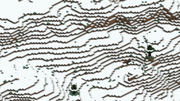 Snowy Tundra |
น้ำแข็งแหลม 140
|
Temperature: 0.0
Packed Ice, Ice, Snow, Snowfall, Snow Blocks, Strays, White and some Black & White Rabbits, Polar Bears, Ice Spikes |
A rare variation of the Snowy Tundra biome that features large spikes and glaciers of packed ice. Usually, the spikes are 10 to 20 blocks tall, but some long, thin spikes can reach over 50 blocks in height. Glaciers replace lakes and are called Ice Patches in code. Almost all grass blocks in this biome are replaced with blocks of snow but occasional grass blocks can be found in hollows and under overhangs. Tall grass is rare. Like the regular snowy tundra, no animal mobs other than rabbits and polar bears are able to spawn and strays appear at night. |
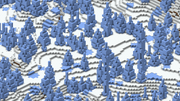 Ice Spikes |
ไทกาหิมะ 30
|
Temperature: -0.5
Snow, Snowfall, Ice, Spruce Trees, Flowers, Wolves, White and some Black & White Rabbits, Foxes, Igloos, Villages[รุ่น Bedrock เท่านั้น], Pillager outposts, Sweet berry bushes |
Much like the regular Taiga, the Snowy Taiga has large expanses of spruce trees, ferns, and their taller variants, generate here commonly, although tall grass can still be found. It is one of the few places where wolves and foxes spawn naturally. One may also find an igloo nestled between the trees from a more or less flat terrain, making it one of only two biomes where igloos naturally generate. Villages[BE เท่านั้น] and outposts[BE เท่านั้น] may also generate here. Villages use the same architecture as taiga villages but the villagers wear snowy biome outfits. |
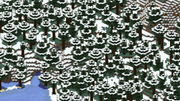 Snowy Taiga |
ภูเขาไทกาหิมะ 158
|
Temperature: -0.5
Spruce Trees, Snow, Snowfall, Ferns, Wolves, Sweet berry bushes, Foxes, White and some Black & White Rabbits |
The Snowy Taiga Mountains are not nearly as flat as their regular counterpart. Compared to the regular Taiga Mountains, the mountains found in this biome are much steeper and more erratic. These large height differences make navigating the snowy taiga mountains biome quite dangerous. Also unlike their normal variant, igloos, villages and outposts do not generate here. |
 Snowy Taiga Mountains |
แม่น้ำแช่แข็ง 11
|
Temperature: 0.0
Ice, Water, Sand, Clay, Seagrass, Rabbit, Polar Bear, Salmon, Drowned, Stray |
A river with a layer of ice covering its surface. It generates only when a River biome enters or meets a Snowy Tundra. Salmon spawn underwater while rabbits and polar bears spawn on ice. At night, Drowned can spawn below the ice with Strays on the surface. No other monsters can spawn here, even underground, except in a spawner. |
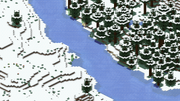 Frozen River |
ชายหาดหิมะ 26
|
Temperature: 0.05
Sand, Snow, Snowfall, Ice, Buried Treasure, Shipwreck, rabbit |
Like a regular beach, one can find plenty of sand in this biome and buried treasure can be found. However, sand is covered in a layer of snow. Snowy beaches are often found when a snowy biome borders an ocean biome. No passive mobs other than rabbits spawn in this biome. |
 Snowy Beach |
ไบโอมหนาว[]
In these biomes, it begins to snow above y=90 in mountains and stone shore, above y=120 in taiga and giant spruce taiga, and above y=150 in giant tree taiga. Otherwise, it rains. Foliage is aqua as in snowy biomes, with the water being indigo.
| Biome Name and ID | คุณลักษณะ | คำอธิบาย | ภาพถ่ายหน้าจอ |
|---|---|---|---|
ภูเขา 3
|
Temperature: 0.2
Oak Trees[JE เท่านั้น], Spruce Trees[JE เท่านั้น], Gravel, Flowers, Emerald Ore, Infested Stone, Llamas |
A highland biome with some mountaintops reaching y=130, with a few scattered oak and spruce trees. Cliffs, peaks, valleys, waterfalls, overhangs, floating islands, caverns, and many other structures exist here, offering outstanding views. This is one of the few biomes where llamas spawn naturally. Snowfall also occurs above certain heights, thus creating snow layers on the top of the mountains. Falling is a significant risk, as there are many steep ledges large enough to cause severe fall damage or even death. Mountains are the only biomes where emerald ore and silverfish can be found naturally. |
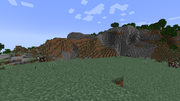 Mountains |
ภูเขาก้อนกรวด 131
|
Temperature: 0.2
Spruce Trees[JE เท่านั้น], Oak Trees[JE เท่านั้น], Gravel, Llama, Emerald ore, Infested stone, Snow |
The mountains in this biome are slightly higher than in their regular counterpart[JE เท่านั้น], many of which reach into the clouds and are covered by snow peaks. The terrain is mainly composed of gravel, with small patches of grass here and there. Due to the low amount of grass, the population of spruce and oak trees in this biome is sparse. When generating alongside an Ocean Biome, it can generate cold or normal beaches. |
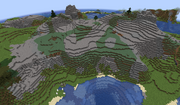 Gravelly Mountains. |
ภูเขาป่า 34
|
Temperature: 0.2
Stone, Dirt, Llama, Emerald ore, Infested stone, Spruce Trees, Oak Trees |
This biome, usually found in the middle of regular mountains biome, generates much taller mountains, most of which are covered by snow. The slopes are quite steep, which makes scaling these mountains difficult and dangerous. The peaks feature much more grass and spruce trees than the Gravelly Mountains, usually forming a small forest at the top. |
 Wooded Mountains |
ภูเขาก้อนกรวด+ 162
|
Temperature: 0.2
Spruce Trees, Oak Trees, Gravel, Llama, Emerald ore, Infested stone, Grass |
This variant of the Wooded Mountains biome removes its signature spruce tree covered peaks in favor of terrain covered mostly by gravel and stone, similar to the Gravely Mountains biome. Larger, deeper valleys are carved into the relatively barren landscape - only a few isolated trees can be found here. Just like the Gravelly Mountains Biome, when generating alongside an ocean biome, beaches generate. |
 Gravelly Mountains+ |
ไทกา 5
|
Temperature: 0.25
Spruce Trees, Flowers, Fern, Wolves, Brown, salt & pepper and black rabbits, Villages, Pillager outposts, Foxes, Sweet berry bushes, |
A predominantly flat biome covered by a forest of spruce trees. Ferns, large ferns and berry bushes grow commonly on the forest floor. You find packs of wolves here, along with small groups of foxes or rabbits. Villages may generate in this biome; the houses in these villages are built of spruce wood. Pillager outposts may also generate here. | 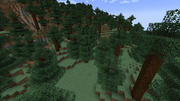 Taiga |
ภูเขาไทกา 133
|
Temperature: 0.25
Spruce Trees, Flowers, Ferns, Sheep, Brown, salt & pepper and black rabbits, Sweet berry bushes, Foxes |
The Taiga Mountains biome also features large spruce forests, but these forests are overlayed onto mountainous terrain. Unlike Taiga Hills, these mountains tend to be larger and more difficult to climb. Perhaps owing to the rough nature of this biome, no villages nor outposts can be found here. |
 Taiga Mountains |
ไทกาต้นยักษ์ 32
|
Temperature: 0.3
Spruce Trees, Podzol, Ferns, Wolves[JE เท่านั้น][กำลังมา: BE 1.16.0], Brown, salt & pepper and black rabbits[JE เท่านั้น], Foxes, Mossy Cobblestone, Mushrooms, Dirt, Coarse Dirt, Dead Bush |
The Giant Tree Taiga is a rare cold biome composed of spruce trees, much like the standard Taiga biome. However, some trees are 2×2 thick and quite tall, akin to large jungle trees. Mossy cobblestone boulders appear frequently, brown mushrooms are common, and podzol can be found on the forest floor. There are also patches of coarse dirt that do not grow grass, with some dead bushes. Wolves and foxes may also spawn here, as they do in normal Taiga biomes. Rabbits may also spawn here in Java Edition. |
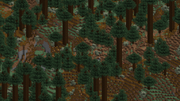 Giant Tree Taiga |
ไทกาต้นสนยักษ์ 160
|
Temperature: 0.25
Spruce Trees, Podzol, Ferns, Grass, Foxes, Wolf[JE เท่านั้น][กำลังมา: BE 1.16.0], Mossy Cobblestone, Mushrooms, Dirt |
The terrain in this rare biome is almost exactly the same as in its regular counterpart. However, the most striking feature of this biome is its giant spruce trees, which are essentially a scaled-up version of regular spruce trees. One can easily differentiate this from a normal Giant Tree Taiga by observing how the leaves almost completely cover the tree trunks, whereas, in normal Giant Tree Taigas, leaves tend to cover only the top. |
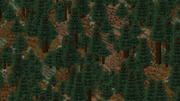 Giant Spruce Taiga |
ชายฝั่งหิน 25
|
Temperature: 0.2 | True to its name, this stone-covered biome often appears where mountain biomes meet the ocean. Depending on the height of the nearby land, Stone Shores may generate as medium slopes or huge cliffs, its tops tall enough to be covered by snow. No passive mobs spawn here. Buried treasure can generate here. |
 Stone Shore |
ไบโอมปานกลาง/เขียวชะอุ่ม[]
In these verdant biomes, it begins snowing over the 256 block height limit, snow does not generate naturally. Otherwise, it rains. The foliage and grass is a vibrant light green, except for swamps and dark forests, which have dark green grass. Rivers and birch forests are also exempt from this, as they have a dull aqua hue. The water is blue in this biome.
| Biome Name and ID | คุณลักษณะ | คำอธิบาย | ภาพถ่ายหน้าจอ |
|---|---|---|---|
ที่ราบลุ่ม 1
|
Temperature: 0.8
Tall Grass, Grass, Flowers, Villages, Horses, Donkeys, Pillager outposts, Oak Trees, Bee Nest |
A flat and grassy biome with rolling hills and few oak trees. Lakes, small underwater caves and villages are common. Cave openings, lava lakes and waterfalls are easily identifiable due to the flat unobstructed terrain. Farm mobs are easily found in Plains biomes; this biome and its variants are also one of the only biomes where horses spawn naturally. Pillager outposts may also be generated. | 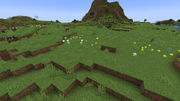 Plains |
ที่ราบลุ่มทานตะวัน 129
|
Temperature: 0.8
Grass, Sunflowers, Flowers, Donkeys, Villages[BE เท่านั้น], Pillager Outposts[BE เท่านั้น], Horses, Oak Trees, Bee Nest |
Found within normal plains, this biome is the only place where sunflowers naturally generate, hence the name. They grow in abundance, making yellow dye a widely available resource. | 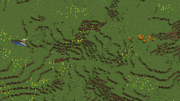 Sunflower Plains |
ป่า 4
|
Temperature: 0.7
Oak and Birch Trees, Flowers, Wolves[JE เท่านั้น][กำลังมา: BE 1.16.0], Bee nests[JE เท่านั้น][กำลังมา: BE 1.16.0] Mushrooms |
A small and very common biome, with a lot of oak and birch trees, occasional hills and a fair amount of tall grass, mushrooms and flowers. This is one of the most preferred biomes to start out in, due to the abundance of wood. Like in taigas, wolves are found. | 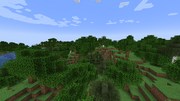 Forest |
ป่าดอกไม้ 132
|
Temperature: 0.7
Flowers, Trees, Brown, salt & pepper and black rabbits, Bee Nest |
This Forest variant has fewer trees, but more than makes up for it - it is almost overflowing with nearly every type of flower and tall plant in the game, several of which grow only in this biome. Therefore, this biome is optimal for harvesting and farming dyes. Wolves do not spawn in the flower forest, although rabbits spawn occasionally. | 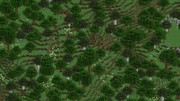 Flower Forest |
ป่าเบิร์ช 27
|
Temperature: 0.6
Birch Trees, Flowers, Bee nests[JE เท่านั้น][กำลังมา: BE 1.16.0] |
A forest where the grass is aqua and only birch trees generate. Unlike in the regular Forest, no wolves spawn. | 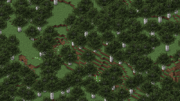 Birch Forest |
ป่าเบิร์ชต้นสูง 155
|
Temperature: 0.7
Tall Birch Trees, Flowers Bee nests[JE เท่านั้น][กำลังมา: BE 1.16.0] |
Birch trees grow much taller than usual in this uncommon variant of the Birch Forest biome. Whereas normal birch trees grow up to 7 blocks tall, these trees usually are 11 blocks in height. This makes deforestation a much more difficult task, although it provides the player with far more resources. Additionally, the terrain in this biome is much rougher and more erratic than birch forest hills. |  Tall Birch Forest |
ป่าสีเข้ม 29
|
Temperature: 0.7
Dark Oak trees, Huge Mushrooms, Mushrooms, Rose Bushes, Woodland Mansions |
This biome is composed of dark oak trees, a mostly closed roof of leaves, and occasional large mushrooms. Trees in this forest are so packed together, that it's dark enough for hostile mobs to spawn, even during the day. On rare occasions, a woodland mansion may spawn. Therefore, the Dark Forest is the only biome in which the woodland mansions can be found. |  Dark Forest |
เนินเขาป่าสีเข้ม 157
|
Temperature: 0.7
Dark Oak Trees, Huge Mushrooms, Woodland Mansions |
A variant of the Dark Forest where large hills dominate the canopy. While increased light in the forest means slightly fewer mobs, the steep cliffs lining this biome still make it dangerous to navigate on foot. |  Dark Forest Hills |
หนองบึง 6
|
Temperature: 0.8
Swamp Huts, Oak Trees, Grass, Vines, Lily Pads, Clay, Mushrooms, Slimes, Huge Mushrooms[รุ่น Bedrock เท่านั้น], Fossils, Seagrass |
A biome characterized by a mix of flat areas around sea level and shallow pools of green water with floating lily pads. Clay, sand, and dirt are commonly found at the bottom of these pools. Trees are covered with vines and can be found growing out from the water. Mushrooms and sugar canes are abundant. Swamp Huts with a black cat and a witch generate exclusively in swamps. Slimes also spawn naturally at night, most commonly on full moons. Some zombies may end up underwater, which can transform them into drowned, making this an especially dangerous biome at night. Temperature varies within the biome, causing foliage and grass colors to vary.
ในรุ่น Bedrock, huge mushrooms also spawn in this biome. Visibility is also lower when the player is underwater. |
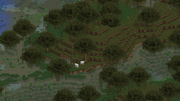 Swamp 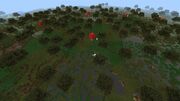 Swamp in Bedrock Edition |
เนินเขาหนองบึง 134
|
Temperature: 0.8
Oak Trees, Vines, Lilypads, Huge Mushrooms[BE เท่านั้น], Water, Swamp huts[BE เท่านั้น], Fossils |
This rare biome has areas where small hills rise in slopes of varying degrees, surrounded by flatter marshes. Beaches generate when this biome borders an ocean biome. ในรุ่น Java, Swamp huts do not generate in this biome, unlike the normal Swamp. |  Swamp Hills |
ป่าดงดิบ 21
|
Temperature: 0.95
Jungle Trees, Oak Trees, Jungle Pyramids, Ferns, Melons, Flowers, Vines, Cocoa Pods, Ocelots, Parrots, Bamboo Pandas[BE เท่านั้น] |
A dense and uncommon temperated biome. It features ferns and large jungle trees that can reach up to 31 blocks tall with 2×2 thick trunks. Oak trees are also common. The landscape is lush green and quite hilly, with many small lakes often nestled into deep valleys, sometimes above sea level. Leaves cover much of the forest floor—these "bush trees" have single-blocks of jungle wood for trunks, surrounded by oak or jungle leaves. When inside a jungle, the sky becomes noticeably lighter as in dry biomes. Vines are found alongside most blocks and may cover the surface of caves. Ocelots, pyramids, melons, cocoa, pandas and parrots exclusively generate in this biome. Melons generate in patches, similar to pumpkins, but are common. | 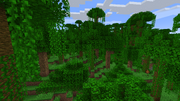 Jungle |
ป่าดงดิบแบบขยาย 149
|
Temperature: 0.95
Jungle Trees, Oak Trees, Ferns, Melons, Flowers, Vines, Cocoa Pods, Ocelots, Parrots, Bamboo Pandas[BE เท่านั้น] |
Much more mountainous version of the normal Jungle, with foliage so thick that the ground is barely visible. This biome is demanding of a player's survival resources. One may confuse this with the Jungle Hills, but the hills in the Modified Jungle biome tends to be sharper and more erratic. Due to the combined height of the terrain and of the tall jungle trees, trees in this jungle frequently reach above the clouds. Extremely dense foliage and treacherous terrain make this biome difficult and dangerous to navigate, especially at night. |  Modified Jungle |
ชาบขอบป่าดงดิบ 23
|
Temperature: 0.95
Jungle Trees, Oak Trees, Ferns, Melons, Flowers, Vines, Cocoa Pods, Ocelots, Parrots, Bamboo Pandas[BE เท่านั้น] |
This biome represents a smooth transition between jungles and other biomes. In stark contrast to the wild and overgrown vegetation of the jungle biomes, the jungle edge consists of a few small and isolated jungle trees, with patches of melons here and there. The terrain is relatively flat, with some small rises in elevation. All mobs that spawn in the Jungle, including parrots, ocelots, and pandas[รุ่น Bedrock เท่านั้น], also spawn in the Jungle Edge. | 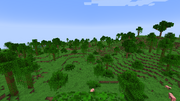 Jungle Edge |
ชายขอบป่าดงดิบแบบขยาย 151
|
Temperature: 0.95
Jungle Trees, Oak Trees, Ferns, Melons, Flowers, Vines, Cocoa Pods, Ocelots, Parrots, Bamboos Pandas[BE เท่านั้น] |
The terrain in this biome is a slightly more hilly and rugged version of the normal Jungle Edge, though some large and flat sections of it are often hard to distinguish from its standard variant. Modified Jungle Edge is the rarest biome in the game and usually generates only when Modified Jungle biomes meet Swamp Hills biomes. The result is a two-layer transition zone that includes a Modified Jungle Edge along the side of the Modified Jungle, and a thin border of normal Jungle Edge on the side of the Swamp Hills. Since Modified Jungles and Swamp Hills are both already rare biomes, in addition to the fact that Modified Jungles are less likely to spawn on the outside edges of jungle biome groups, the Modified Jungle Edge biome is extremely rare. The strict conditions that are needed for its generation also make it a small biome when it does occur, usually no longer than 150 blocks on its long side and less than that for width. |  Modified Jungle Edge |
ป่าดงดิบไม้ไผ่ 168
|
Temperature: 0.95
Jungle Trees, Oak Trees, Podzols, Vines, Ocelots, Jungle Pyramids[รุ่น Java เท่านั้น], Melons, Parrots, Bamboos, Pandas |
The terrain in this biome is covered by grass with some patches of podzol. Unlike the normal Jungle, bushes still generate but do not cover the floor. Additionally, only large jungle trees can generate here along with large or balloon oak trees. The density of trees in this biome is much less compared to jungle edge, but massive amounts of bamboo shoots generate covering this biome. Jungle exclusive mobs such as ocelots and parrots can spawn in here. Panda exclusively spawn in this biome[รุ่น Java เท่านั้น] or have a much higher spawn rate than in regular jungle.[รุ่น Bedrock เท่านั้น] Jungle pyramids can also generate.[รุ่น Java เท่านั้น] | 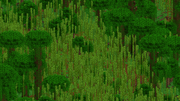 Bamboo Jungle |
แม่น้ำ 7
|
Temperature: 0.5
Water, Sand, Clay, Sugar Cane, Seagrass, Salmon, Squid, Drowned |
A biome that consists of water blocks that form an elongated, curving shape similar to a real river. Unlike real rivers, however, they have no current. Rivers cut through terrain or separate the main biomes. They attempt to join up with Ocean biomes, but sometimes loop around to the same area of ocean. Rarely, they can have no connection to an ocean, instead of forming a loop. The grass have a dull aqua tone, much like the ocean, and trace amounts of oak trees tend to generate there as well. Rivers are also a reliable source of clay. These biomes are good for fishing, but drowned can spawn at night. Mobs other than salmon, squid and drowned cannot spawn in this biome, even underground, except in a spawner. | 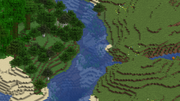 River |
ชายหาด 16
|
Temperature: 0.8
Sand, Gravel, Water, Sugar Cane, Turtles, Buried Treasure, Shipwreck |
Generated where oceans meet other biomes, beaches are primarily composed of sand. Beaches penetrate the landscape, removing the original blocks and placing in sand blocks. These are also useful for fishing. Passive mobs other than turtles do not spawn on beaches. For the history of beaches, see the Beach page. | 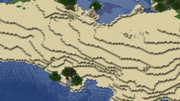 Beach |
ทุ่งเห็ด 14
|
Temperature: 0.9
Mushrooms, Huge Mushrooms, Mycelium, Mooshrooms, No Hostile Mobs |
This rare biome consists of a mixture of flat landscape and steep hills and has mycelium instead of grass as its surface. However, any grass placed appears in a bright green color, even brighter than in the Jungle. Mushroom fields are most often adjacent to an ocean and are usually found isolated from other biomes, and they are typically a few hundred blocks wide. It is one of the only biomes where huge mushrooms can generate naturally, and where mushrooms can grow in full sunlight.
No mobs other than mooshrooms spawn naturally in this biome, including the usual night-time hostile mobs. This also applies to caves, mineshafts, and other dark structures, meaning exploring underground is safe. However, mob spawners still spawn mobs, wandering traders along with their llamas can spawn, raids can still spawn illagers, and the player can still breed animals and spawn mobs using spawn eggs. |
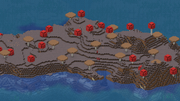 Mushroom Fields |
ชายฝั่งทุ่งเห็ด 15
|
Temperature: 0.9
Mushrooms, Huge Mushrooms, Mycelium, Mooshrooms, Buried Treasure, Shipwreck, No Hostile Mobs |
Mushroom Field Shores represent the transition between mushroom fields and the ocean, forming long strips between the biomes as a "beach", hence the name. However, it does not generate if the ocean biome is a Deep Ocean. This biome also generates when a river meets a Mushroom Fields biome, similar to what Frozen Rivers do in Snowy Tundras. The terrain of this biome is much more flat and shallow than the main Mushroom Fields biome, though it contains many of the same features, such as a mycelium surface layer, huge mushrooms, and lack of hostile mobs, but shipwrecks and buried treasure can generate here. |  Mushroom Field Shore |
ไบโอมของดิเอนด์[]
The End is considered a different dimension. The water is lilac.[Bedrock Edition only]
| Biome Name and ID | คุณลักษณะ | คำอธิบาย | ภาพถ่ายหน้าจอ |
|---|---|---|---|
ดิเอนด์ 9
|
Temperature: 0.5
End Stone, Endermen, Obsidian, End Crystals, Ender Dragon, End gateway portal, Void |
This biome is used to generate the circle of radius 1000 centered at the 0,0 coordinates in the End. The End central island is generated at the center of this circle, and it's surrounded by a complete vacuum all the way to the edge of the biome. Most of the End features are exclusive to that island, including the ender dragon, the obsidian pillars, the End Crystals, the 5x5 spawn platform, the exit portal and the 20 central End gateways. Large amounts of endermen spawn in this biome. It does not rain or snow in this biome unlike the other low-temperature biomes. The outer islands in the End can be accessed using the End gateway portal after the ender dragon has been defeated. If the biome is used for a superflat world, the sky appears nearly black and an ender dragon spawns at the 0,0 coordinates in the Overworld. Only endermen spawn at night. ในรุ่น Bedrock, this biome contains the entire End dimension. |
 The End |
เกาะเอนด์ขนาดเล็ก 40
|
Temperature: 0.5
End stone, Endermen, End gateway portals, Void |
[รุ่น Java เท่านั้น] Generates as part of the outer islands of the End. This biome represents the empty expanse between the larger islands, populated only by the smaller, circular islands. |
 Small End Islands |
เกาะเอนด์ตอนกลาง 41
|
Temperature: 0.5
End stone, Endermen, End gateway portals, End Cities, Shulkers |
[รุ่น Java เท่านั้น] Generates as part of the outer islands of the End. This biome represents the gradual slope from the hilltops of each island down to the cliffs around the edge. End cities generate here, but chorus trees do not. |
 End Midlands |
ที่สูงเอนด์ 42
|
Temperature: 0.5
End Stone, Endermen, Chorus Plants, End Cities, Shulkers, End gateway portals |
[รุ่น Java เท่านั้น] Generates as part of the outer islands of the End. This biome represents the hilltops of each island, and is the only biome in the End where both chorus trees and end cities generate. |
 End Highlands |
ที่แห้งแล้งเอนด์ 43
|
Temperature: 0.5
End stone, Endermen, End gateway portals |
[รุ่น Java เท่านั้น] Generates as part of the outer islands of the End. This biome represents the outer rims of each island, with steep cliffs below the edge. Neither end cities nor chorus trees generate in this biome. |
 End Barrens |
ไบโอมแห้ง/อุ่น[]
In these biomes, it neither rains nor snows at all, but the sky still turns overcast during inclement weather. The foliage and grass is an olive tone, except badlands biomes, which have brown grass. The water is light green. As in jungle biomes, the sky becomes lighter. Additionally, a snow golem spawned or brought into one of these biomes melts unless it has the Fire Resistance effect.
| Biome Name and ID | คุณลักษณะ | คำอธิบาย | ภาพถ่ายหน้าจอ |
|---|---|---|---|
ทะเลทราย 2
|
Temperature: 2.0
Sand, Cacti, Dead Bushes, Sandstone, Sugar Cane, Desert wells, Desert Pyramids, Desert Villages, Pillager Outposts, Gold Rabbits, Fossils, Husk |
A barren and inhospitable biome consisting mostly of sand dunes, dead bushes, and cacti. Sandstone, and sometimes fossils, are found underneath the sand. The only passive mobs to spawn naturally in deserts are gold/creamy rabbits, their coloring well-camouflaged against the sand. At night, husks usually spawn in the place of normal zombies; the lack of visual obstruction makes hostile mobs highly visible. Sugar cane can be found if the desert is next to an ocean or river biome. Desert villages, desert wells, and desert pyramids are found exclusively in this biome. Pillager outposts can also generate here. This biome sometimes appears as a thin edge around badlands biomes. |
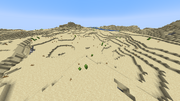 Desert |
ทะเลสาบทะเลทราย 130
|
Temperature: 2.0
Sand, Cacti, Water, Sugar Canes, Gold Rabbits, Desert well, Fossils, Husk |
In this biome, unlike the normal Desert, patches of water can be found, and the terrain is slightly more rough. Although desert wells can be found, desert pyramids, villages, and outposts do not generate in this biome. |
 Desert Lakes |
สะวันนา 35
|
Temperature: 1.2
Acacia Trees, Tall Grass, Savanna Villages, Horses, Cows, Pillager Outposts, Sheep, Llamas |
A relatively flat and dry biome with a dull-brown grass color and acacia trees scattered around the biome, though oak trees may generate now and then. Tall grass covers the landscape. Villages can generate in this biome, constructed of acacia wood, with some colored terracotta. Pillager outposts can also generate here. Both horses and llamas naturally spawn here. |
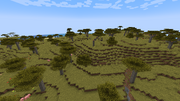 Savanna |
สะวนันนาแตกหัก 163
|
Temperature: 1.1
Acacia Trees, Oak Trees, Coarse Dirt, Tall Grass, Llama |
Unlike the flat and calm terrain of the savanna biome, the chaotic terrain of this uncommon variant is covered in gigantic mountains covered in coarse dirt and some patch of stone. The mountains in the shattered savanna biome are extremely steep, jutting out at 90-degree angles, making it almost impossible to climb. Deep Ocean-like lakes also generate here. On top of that, they dwarf the mountains biome in height - they can rise far above the clouds, and even to the world height limit, without using the Amplified world type.[รุ่น Java เท่านั้น] Massive waterfalls and lavafalls are quite common here. The unforgiving terrain means villages and outposts do not generate in this biome. Surprisingly, llamas can spawn here. | 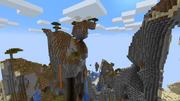 Shattered Savanna |
แบดแลนด์ 37
|
Temperature: 2.0
Dead Bushes, Terracotta, 6 colors of Terracotta, Red Sand, Cacti, Red Sandstone[JE เท่านั้น], Above ground mineshafts, Gold ore |
A rare biome where large mounds of terracotta and stained terracotta generate. Red sand also generates here instead of regular sand, with occasional cacti and dead bushes, and this biome is usually bordered by a desert biome. No passive mobs spawn in this biome, even if all other spawning conditions are met. Mineshafts generate at a higher altitude than normal - occasionally a player may come across a mineshaft jutting out of the Badlands. Gold ore also occurs more frequently, because ore veins generate within badlands at a higher Y-level than the usual 32. The composition of this biome is useful when other sources of terracotta and gold are scarce. However, finding badlands biomes can be difficult due to their rarity. On the other hand, it offers great variety; six variations of this biome are available to explore.
|
 Badlands |
แบดแลนด์กัดเซาะ 165
|
Temperature: 2.0
Red Sand, Cacti, Red Sandstone[JE เท่านั้น], Dead Bushes, Terracotta 6 colors of Terracotta, Above ground mineshaft, Gold ore |
This rare biome generates unique terrain features that are similar to the structures in Utah's Bryce Canyon. Tall and narrow spires of colorful terracotta rise out of the floor of the canyon, which like all other badlands variants, is covered in red sand. Deserts do not generate alongside this biome. |
 Eroded Badlands |
ป่าบนที่ราบสูงแบดแลนด์ 38
|
Temperature: 2.0
Oak trees, Dead Bushes, Dirt, Terracotta, 6 colors of Terracotta |
One might not notice the difference between the normal badlands plateau and this variation, if it weren't for the layer of coarse dirt and the small forests of oak trees that generate atop these plateaus. The color of the grass and leaves is a dull green-brown hue, giving it a dried and dead appearance. These trees are a rare source of wood when living in the otherwise barren and lifeless badlands. |
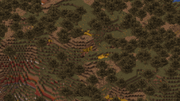 Wooded Badlands Plateau |
ป่าบนที่ราบสูงแบดแลนด์แบบขยาย 166
|
Temperature: 2.0
Oak trees, Dead Bushes, Dirt, Terracotta, 6 colors of Terracotta |
This biome features grass and oak trees on top of plateaus, much like its counterpart. However, the plateaus that generate here are generally smaller, allowing far less foliage to generate. The terrain is more erratic, and can be compared to that of the similar Modified Badlands Plateau biome, having an old and eroded appearance. Deserts do not generate alongside this biome. |
 Modified Wooded Badlands Plateau |
| ที่ราบสูง 36, 39
|
Temperature: Badlands Plateau : 2.0 |
Savanna plateau biomes are similar to the Hills biomes, but generate only within Savanna, while badlands plateau generate as actual biomes in Badlands biomes, and are flattened at the top, much like real-life plateaus. They come to rest at an elevation of about 20 to 30 blocks above sea level. One may discover the entrance to a mineshaft within the tall slopes of a Badlands Plateau. |
 Badlands Plateau 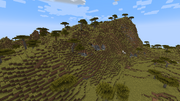 Savanna Plateau |
| ที่ราบสูงแบบขยาย 164, 167 |
Temperature: Modified Badlands Plateau : 2.0 |
Two rare variants of the plateau biomes, which are variants themselves. However, neither of these biomes closely resemble their counterparts.
Compared to the average Badlands Plateau, the Modified Badlands Plateau features more variable terrain and smaller plateaus, as if a larger plateau was weathered down over time. The terrain of the Shattered Savanna Plateau biome is much less tame than its normal counterpart. It features incredibly large and steep mountains that jut out of the terrain, similar to the Shattered Savanna biome, albeit slightly smaller and gentler in comparison. Rain can occur in shattered savanna plateau.[BE เท่านั้น] |
 Modified Badlands Plateau  Shattered Savanna Plateau |
ไบโอมเนเธอร์[]
Like the End, the Nether is a different dimension. All biomes in this dimension are dry and it is not possible to place water in these biomes, though ice can still be placed.
| Biome Name and ID | คุณลักษณะ | คำอธิบาย | ภาพถ่ายหน้าจอ | |
|---|---|---|---|---|
ที่เสียเนเธอร์ 8
|
Temperature: 2.0
Netherrack, Glowstone, Soul Sand, Nether Quartz Ore, Ghasts, Blazes, Zombie Pigmen, Nether Fortresses, Wither Skeletons, Lava, Magma cubes, Gravel, Magma Blocks, Bastion Remnants[กำลังมา], Ruined Portals[กำลังมา] |
This is the biome used to generate the Nether. Within this biome spawn mobs such as ghasts, packs of zombie pigmen and the occasional magma cubes and endermen. Certain structures, such as Nether quartz ore & glowstone veins, and Nether fortresses generate only in the Nether. Water lakes (and other Overworld structures) can still generate if the Nether is used in a superflat preset. Beds explode when used in this biome. |
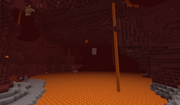 Nether Wastes, formerly only called "Nether" | |
| Temperature: 2.0
Netherrack, Glowstone, Soul Sand, Stone, Water, Lava, Gravel, Nether fortresses (when generated through Buffet mode) | ||||
| Temperature: 2.0
Stone, Lava, Water, Bedrock, Zombie Pigman, Ghast, Magma Cube (when generated in overworld)[รุ่น Bedrock เท่านั้น] | ||||
หุบเขาทรายวิญญาณ [กำลังมา: JE 1.16 & BE 1.16.0] 170 |
Temperature: 2.0
Soul Sand, Soul Soil, Soul Fire, Netherrack, Basalt in Basalt pillars, Bone Blocks in Nether fossils, Ghast, Skeleton, Endermen, Bastion Remnants, Ruined Portals |
The soul sand valley is a large grotto that is extensive and cuts through the Nether's usual terrain. Notable features of the biome are exposed nether fossils in various shapes and sizes, large amounts of lava, blue fog, large spires made of basalt, soul fire, and the occasional Nether fortress. The biome itself consists of soul sand, basalt and soul soil.
This biome is extremely dangerous to traverse, due to the high spawn rate of ghasts, frequent groups of skeletons and endermen, and soul sand slowing down the player's movement speed. It is recommended to avoid this biome unless players have sufficient equipment/strategies to navigate the terrain. |
 Soul Sand Valley | |
ป่าสีเลือด [กำลังมา: JE 1.16 & BE 1.16.0] 171 |
Temperature: 2.0
Crimson Nylium, Crimson Fungi, Warped Fungi, Crimson Roots, Glowstone, Weeping Vines, Huge Crimson Fungi, Nether Wart Blocks, Shroomlight, Hoglins, Piglins, Zombified Piglins, Bastion Remnants, Ruined Portals |
The Crimson Forest is a “red” crimson-themed biome, with warped and crimson fungi as well as huge crimson fungi scattered around the environment.
There are huge fungi structures that contain weeping vines hanging off them and may also have a few blocks of shroomlight. The floor of the biome is covered in crimson nylium, with crimson roots growing. Occasional patches of netherrack and red nether wart blocks are found scattered throughout the biome. In the ceiling, apart from glowstone clusters, there are sparse nether wart block stalactites with vines growing. Piglins, zombified piglins and hoglins naturally spawn in this biome. The abundance of hoglins in this biome makes it a great source of food in the Nether. |
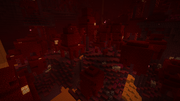 Crimson Forest | |
ป่าวิปริต [กำลังมา: JE 1.16 & BE 1.16.0] 172 |
Temperature: 2.0
Warped Nylium, Crimson Fungi, Warped Fungi, Warped Roots, Nether Sprouts, Huge Warped Fungi, Warped Wart Blocks, Shroomlight, Enderman, Bastion Remnants, Ruined Portals |
The warped forest is a dense, “blue” warped-themed biome, with warped and crimson fungi as well as huge warped fungi scattered around.
The huge fungi structures may have a few blocks of shroomlight scattered around them. The floor of the biome is covered in warped nylium, with warped roots and nether sprouts growing. Occasional patches of raw netherrack and warped wart blocks can be found scattered throughout the biome. Endermen are the only mobs that spawn in this biome, and they spawn frequently. This makes the warped forest an ideal location to collect ender pearls to access the End. This biome is also a relatively safe place to reside in the Nether, due to the fact that no hostile mobs spawn here (except those that are spawned with bastion remnants, which generate in this biome.) |
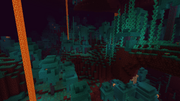 Warped Forest | |
สันดอนหินบะซอล์ต [กำลังมา: JE 1.16 & BE 1.16.0] 173 |
Temperature: 2.0
Basalt, Blackstone, Netherrack, Lava, Magma Cubes, Striders, Ghasts, Ruined Portals |
A gray biome, the Basalt Deltas are said to be the remnant of ancient volcanic eruptions.
The ground consists of basalt and blackstone blocks, with small patches of netherrack and pools of lava. The shape of the terrain is chaotic and uneven, making it somewhat difficult to traverse and build on. As a result, bastion remnants do not generate in this biome. When this biome borders a lava ocean, clusters of basalt form near the coast. Magma cubes have a high spawn rate in this biome, making the Basalt Deltas the best place to farm Magma Cream. |
 Basalt Deltas |
ไบโอมมหาสมุทร[]
Oceans are large, open biomes made entirely of water going up to y=63, with underwater relief on the sea floor, such as small mountains and plains, usually including gravel. Oceans typically extend under 3,000 blocks in any direction; around 60% of the Overworld's surface is covered in ocean. Small islands with infrequent vegetation can be found in oceans. Passive mobs sometimes can spawn on these islands, as hostiles can. Squid spawn frequently in the water. Underwater cave entrances can be found frequently at the bottom of the ocean.
| Biome Name and ID | คุณลักษณะ | คำอธิบาย | ภาพถ่ายหน้าจอ |
|---|---|---|---|
มหาสมุทรอุ่น 44
|
Temperature: 0.5
Dolphins |
A variant of the Ocean biome, with light green water at the surface. Like the Lukewarm Ocean, it has a floor made of sand, and like all oceans, it is populated with seagrass. Unlike other ocean biomes, Warm Oceans allow for the generation of coral reefs and sea pickles, but not kelp. | 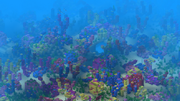 Warm Ocean |
มหาสมุทรอุ่นปานกลาง 45
|
Temperature: 0.5
Dolphins, Pufferfish[JE เท่านั้น], Tropical fishes[JE เท่านั้น], Squid, Salmon[BE เท่านั้น] Cod, warm underwater ruins, Sand, Dirt, Clay, Drowned, Kelp, Seagrass, Shipwrecks, Magma blocks |
A variant of the Ocean biome, with light teal water at the surface. Its floor is made of sand with the occasional dirt or clay, and it contains kelp and seagrass. Unlike the Warm Ocean biome, cod and salmon[BE เท่านั้น] can spawn here. | 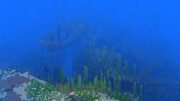 Lukewarm Ocean |
มหาสมุทรอุ่นปานกลางลึก 48
|
Temperature: 0.5
Dolphins, Pufferfish[JE เท่านั้น], Tropical fishes[JE เท่านั้น], Salmon[BE เท่านั้น] Cod, warm underwater ruins, Sand, Dirt, Clay, Drowned, Squid, Kelp, Seagrass, Ocean monuments, Guardians, Elder guardians, shipwrecks, Magma Blocks |
Similar to the Lukewarm Ocean biome, but twice as deep. Because they are a Deep Ocean variant, they can generate ocean monuments, resulting in the spawning of guardians, elder guardians, prismarine, and sponges. | 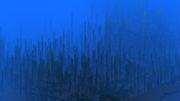 Deep Lukewarm Ocean |
มหาสมุทร 0
|
Temperature: 0.5
Water, Gravel, Squid, Sand, Seagrass, Kelp, Shipwreck, Cold Underwater ruins, Cod, Salmon[BE เท่านั้น], Drowned, Magma block |
The basic Ocean biome. Like its colder variants, its floor is made up of gravel. Sea grass, kelp, cod and salmon[รุ่น Bedrock เท่านั้น] can spawn here. |
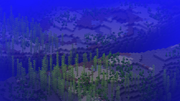 Ocean |
มหาสมุทรลึก 24
|
Temperature: 0.5
Water, Gravel, Clay, Squid, Guardians, Elder Guardians, Ocean monuments, Shipwreck, Cold underwater ruins, Kelp, Seagrass, Cod, Salmon, Drowned, Magma Block |
A variant of the Ocean biome. In Deep Ocean biomes, the ocean can exceed 30 blocks in depth, making it twice as deep as the normal ocean. The ground is mainly covered with gravel. Ocean monuments generate in deep oceans, meaning guardian and elder guardian can spawn here. Underwater ravines often generate here, with the top layer of lava being replaced by magma blocks that create bubble columns. |
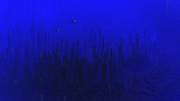 Deep Ocean |
มหาสมุทรเย็น 46
|
Temperature: 0.5
Dolphins, Cod, Salmon, Cold underwater ruins, Gravel, Kelp, Seagrass, Dirt, Sand, shipwreck, magma blocks, squid, Drowned |
A variant of the Ocean biome, with dark indigo water at the surface. Like regular Oceans and Frozen Oceans, its floor is made up of gravel, though you can find some patches of dirt. Salmon are able to spawn in Cold Ocean biomes. | 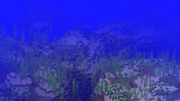 Cold Ocean |
มหาสมุทรเย็นลึก 49
|
Temperature: 0.5
Dolphins, Cod, Salmon, Cold underwater ruins, Gravel, Kelp, Seagrass, Dirt, Sand, Ocean monuments, Guardians, Elder guardians, shipwrecks, Drowned, Squid |
Similar to the Cold Ocean biome, but twice as deep. Like other Deep Oceans, ocean monuments are able to generate here, which contain guardians, elder guardians, prismarine, and sponges. | 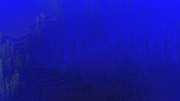 Deep Cold Ocean |
มหาสมุทรแช่แข็ง 10
|
Temperature: 0.0
Ice, Packed Ice, Blue Ice, Water, Gravel, Clay, Squid, Sand, Cod[BE เท่านั้น], Drowned, Salmon, Iceberg, Shipwreck, Cold underwater ruins, Stray, Polar Bear, Rabbit |
A variant of the Ocean biome with dark purple water at the surface. Like the Cold Ocean, it has a gravel seabed and squid swimming about. However, the water's surface is frequently broken up by patches of ice and large icebergs, consisting of packed ice and, occasionally, blue ice. Strays and polar bears can spawn here, but dolphins do not. |
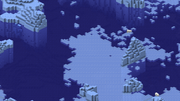 Frozen Ocean |
มหาสมุทรแช่แข็งลึก 50
|
Temperature: 0.5
Salmon, Cold underwater ruins, Gravel, Ice[BE เท่านั้น], Packed Ice, Blue Ice, Ocean monuments, Guardians, Elder guardians, iceberg, shipwreck, Polar Bear, Stray, rabbit, cod[BE เท่านั้น], drowned, squid |
Like the Frozen Ocean biome, the only fish that can spawn here are salmon and cod[BE เท่านั้น], and the floor is made up of gravel. The Frozen Deep Ocean biome also contains ocean monuments and a deeper floor than normal Oceans, like other Deep Oceans. Unlike its shallow counterpart, the surface of the water is not frozen[JE เท่านั้น]. Frequent floating icebergs with blue ice generate here. Polar bears, rabbits, and strays can also spawn here, but dolphins do not. | 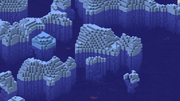 Deep Frozen Ocean |
Neutral Biomes[]
| Biome Name and ID | คุณลักษณะ | คำอธิบาย | ภาพถ่ายหน้าจอ |
|---|---|---|---|
ความว่างเปล่า[รุ่น Java เท่านั้น] 127
|
Temperature: 0.5
Stone, Cobblestone, Void |
Can be accessed only through Buffet world selection or The Void superflat preset. In a Buffet world, the landscape consists only of stone, as well as water and bedrock depending on the generator type. In The Void superflat preset, the world is empty except for a single structure: a 33×33 stone platform with a single block of cobblestone in the center. No mobs (passive or hostile) can spawn without spawn eggs, spawners, or commands. |  The Void |
| เนินเขา 13, 17, 18, 19, 22, 28, 31, 33, 156, 161 |
Temperature: Same as their respective base biomes. | Hills are generated within certain biomes (including some of their variants) and are referred in the F3 menu with Hills or Mountains added to their name.
This includes: Wooded Hills, Taiga Hills, Snowy Taiga Hills, Jungle Hills, Desert Hills, Birch Forest Hills, Tall Birch Hills, Giant Tree Taiga Hills, Giant Spruce Taiga Hills, and Snowy Mountains. Most hills are gentle rolling slopes on which the usual biome terrain generates, with some sharper cliffs here and there. Snowy Mountains are usually taller, with height comparable to mountains biomes, and have a lower chance of spawning passive mobs during world generation than other biomes (7% versus 10%). Giant Spruce Taiga Hills are a special case. ในรุ่น Java, the game code sets the values |
 Giant Tree Taiga Hills  Desert Hills  Jungle Hills  Snowy Mountains |
ไบโอมที่ไม่ได้ใช้แล้ว[]
These biomes don't generate in default worlds.
| Biome Name and ID | คุณลักษณะ | คำอธิบาย | ภาพถ่ายหน้าจอ |
|---|---|---|---|
ขอบภูเขา 20
|
Temperature: 0.2
Grass, Dirt, Stone, Llamas, Emerald ore, Infested stone, Spruce trees, Oak trees, Snow |
Similar to the jungle edge biome, the Mountain Edge used to generate exclusively at the edge of Mountain biomes in order to smooth the transition between biomes. This biome has lots of trees, similar to wooded mountains. While the terrain is lower and gentler in nature, some areas may reach high enough to be covered by snow. This biome doesn't generate naturally from Java Edition 1.7.2 onward. |  Mountain Edge |
มหาสมุทรอุ่นลึก 47
|
Temperature: 0.5
Dolphins, Pufferfish, Tropical fishes, Warm underwater ruins, Sand, Seagrass, Ocean monuments, Guardians, Elder guardians, shipwrecks |
Similar to the Warm Ocean biome, but without coral reefs nor sea pickles, and twice as deep. Because they are a deep ocean variant, they can generate ocean monuments, resulting in the spawning of guardians, elder guardians, prismarine, and sponges. This biome has never naturally generated. | 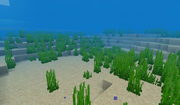 Deep Warm Ocean |
มหาสมุทรแช่แข็งแบบเก่า[รุ่น Bedrock เท่านั้น] -116
|
Temperature: 0.0
Polar Bears, Salmon, Cod, Strays, Cold underwater ruins, Gravel, Seagrass, kelp, Snowy Rabbits, Ice, shipwrecks |
Similar to the Frozen Ocean biome, but without icebergs. Because they are a Frozen Ocean variant, they can spawn polar bears and strays, but not dolphins. Unlike the regular frozen ocean, Polar bear, drowned, squid, salmon, cod, Rabbits, skeletons and strays are only mobs that spawn here, kelp also generates here. This biome doesn't generate naturally from Pocket Edition Alpha 0.9.0 onward. |  Legacy Frozen Ocean |
Removed Biomes[]
These biomes no longer generate in current versions of the game.
| Biome Name and ID | คุณลักษณะ | คำอธิบาย | ภาพถ่ายหน้าจอ |
|---|---|---|---|
ทุนดรา
|
Temperature: <50%
Snow, Grass Block, Ice |
Snowy, barren terrain with few trees. The occasional trees do exist, although rarely. Ice can be found over water. Snow is common weather in tundras. It generates when the temperature is below 50% and the rainfall is less than 20%. |
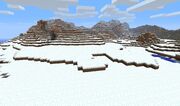 Tundra |
ป่าฝน
|
Temperature: >97%
Grass Block, Grass, Oak trees, Birch trees |
Rainforests are wet biomes with many trees, which have a 1 in 3 chance of being big, instead of 1 in 10 like all other biomes. They generate only oak trees and have a large amount of tall grass and ferns. A biome is classified as a rainforest if the temperature is greater than 97% and the rainfall is more than 90%. This could be the biome with some of the most cliffs and hills because the world generator reduces height variation at lower rainfalls. |
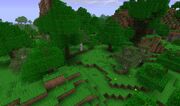 Rainforest |
ป่าตามฤดูกาล
|
Temperature: >97%
Grass Block, Grass, Oak trees |
Seasonal Forests spawn with a temperature of 97% or greater, and a rainfall value between 45% and 90%. They are commonly found between forest and rain forests, and near plains biomes. They are identical to forests, except they have fewer trees and are capable of spawning only oak trees. They have a little bit of tall grass. |
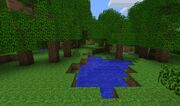 Seasonal Forest |
ทะเลทรายน้ำแข็ง
|
Temperature: 0.0 | An unused biome before Beta 1.8 that was in the code but never implemented into the temperature/rainfall table and thus did not actually generate. It was a biome of sand with snow on top of it and had snowfall and ice. |
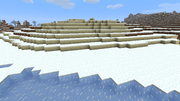 Ice Desert |
ทุ่งไม้พุ่ม
|
Temperature: >50%, <97%
Grass Block, Oak trees, Birch trees |
A biome with few trees and no tall grass. It is identical to the savanna biome. It is one of the smallest biomes in the game and spawns only if the temperature is between 50% and 97%, and the rainfall value is below 35% and therefore too little to generate a forest. |
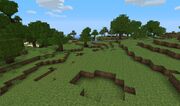 Shrubland |
Biome IDs[]
ไบโอม/ID
สีของไบโอม[]
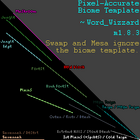
Biome colors template for Java Edition 1.7.2 and above.

grass.png

foliage.png

swamp_foliage.png in bedrock resource. All surface filled with 0x6A7039.
The temperature and rainfall values of a biome are used when determining the colors of a small selection of blocks: grass, grass blocks, some leaves, vines, sugar cane, and other features such as water and the sky. Blocks such as mossy cobblestone, mossy stone bricks and the stems of flowers are not affected by biome coloration.[2]
A biome's rainfall value is typically a value from 0.0 to 1.0, and - as stated above - a biome's temperature starts at a given value at sea level (e.g. 2.0 for Desert or -0.5 for Snowy Taiga) and decreases by 0.00166667 for each meter above sea level.
Biome grass and foliage colors are selected from two 256×256 colormap images: grass.png and foliage.png. Both colormaps, shown to the right, can be found in assets\minecraft\textures\colormap. The grass.png colormap sets the colors for the grass block top and sides (along with other types of grass, such as tall grass, ferns, double tall grass, etc.). Meanwhile, the foliage.png colormap sets the colors for tree leaves (with the exception of spruce and birch).
Biome colormaps use a triangular gradient by default. However, only the colors in the lower-left half of the image are used, even though the upper-right side of foliage.png is colored. Furthermore, as shown in the template image to the left, a select few pixels are considered when the colormap is read by the game, and are determined by the code below.
The adjusted temperature and adjusted rainfall values (recognized as AdjTemp and AdjRainfall in the code, respectively) are used when determining the biome color to select from the colormap. Treating the bottom-right corner of the colormap as Temperature = 0.0 and Rainfall = 0.0, the adjusted temperature increases to 1.0 along the X-axis, and the adjusted rainfall increases to 1.0 along the Y-axis. The values used to retrieve the colors are computed as follows:
AdjTemp = clamp( Temperature, 0.0, 1.0 ) AdjRainfall = clamp( Rainfall, 0.0, 1.0 ) * AdjTemp
"clamp" limits the range of the temperature and rainfall to 0.0-1.0. The clamped rainfall value is then multiplied by the 0.0-1.0 adjusted temperature value, bringing its value to be inside the lower left triangle. Some biomes' ranges are shown in the template above; the multiplication makes all the line segments point toward the lower right corner.
At borders between or among biomes, the colors of the block and its eight neighbors are computed and the average is used for the final block color.
The exact temperature and rainfall values for biomes can be found in various projects, e.g. this biome code.
Hard-coded colors[]
Certain biome colors are hard-coded, which means they are locked into the Minecraft code and are not retrievable from any texture file. Thus, they cannot be modified without the use of external tools, such as MCPatcher/OptiFine, that support the use of custom colormaps.
Swamp color[]
Swamp temperature, which starts at 0.8, is not affected by altitude. Rather, a Perlin noise function is used to gradually vary the temperature of the swamp. When this temperature goes below -0.1, a lush green color is used (0x4C763C) otherwise it is set to a sickly brown (0x6A7039). In addition, the color of the water in swamps is always multiplied by a faint green tinge (0xE0FFAE).
Dark forest color[]
The dark forest biomes' grass color is retrieved normally, then averaged with a dark green color (0x28340A) to produce the final color.
Badlands color[]
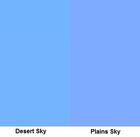
The color of the sky in two different biomes.
All badlands biomes' grass and foliage have hard-coded colors, which are two tan colors (0x90814D and 0x9E814D respectively). These are not modifiable by grass.png and foliage.png, and are unaffected by temperature.
Other colors[]
Several other biome colors are set into the game and currently require external tools in order to be changed. This includes blocks such as birch and spruce leaves and water (which have a hard-coded overlay set onto them), and other features such as the sky and fog.[ต้องการข้อมูลเพิ่มเติม]
ความสำเร็จ[]
| ไอคอน | Achievement | คำอธิบายในเกม | ความต้องการที่แท้จริง (ถ้าแตกต่าง) | มีอยู่ | Xbox points earned | Trophy type (PS) | |||
|---|---|---|---|---|---|---|---|---|---|
| Xbox | PS | Nintendo | |||||||
| Adventuring Time | Discover 17 biomes | Visit any 17 biomes. Does not have to be in a single world. | Yes | Yes | Yes | Wii U, Switch | 40G | Silver | |
| Sail the 7 Seas | พบไปโอมมหาสมุทรทั้งหมด (Visit all ocean biomes | Visit all ocean biomes except the deep warm ocean (as it is unused)) | No | PS4 | Yes | No | 40G | Gold | |
ความก้าวหน้า[]
| ไอคอน | ความก้าวหน้า | คำอธิบายในเกม | ก่อนหน้านี้ | ความต้องการที่แท้จริง (ถ้าแตกต่าง) | ไอดีภายใน | ||
|---|---|---|---|---|---|---|---|
 | Adventuring Time | ค้นพบไบโอมทุกชนิด (Discover every biome) | Sweet dreams |
| minecraft:adventure/adventuring_time |
ประวัติ[]

An old image of biomes work-in-progress. "To the right of the player is a taiga, to the left is either a forest, or woods, I can’t remember. In the distance is probably tundra." – Notch

The biomes graph from Notch, prior to Java Edition Beta 1.8. Notice the chicken scratch handwriting, as Notch was working quick to try to get the biomes update out.
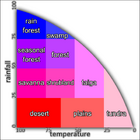
The old biomes graph with linear axes.
| รุ่น Java Alpha | |||||
|---|---|---|---|---|---|
| v1.0.4 | Added Winter Mode. Maps now have a snowy or grassy theme randomly determined when creating the world. | ||||
| v1.2.0 | preview | Added true biomes; they were rain forest, seasonal forest, forest, shrubland, taiga, tundra, savanna, plains, swampland, desert, and frozen desert. | |||
| World saves remained unchanged, other than a change in the hue of the grass. If the player moves into ungenerated chunks, the new biomes would generate. | |||||
| รุ่น Java Beta | |||||
| 1.6 | Added the Sky Dimension with its own biome. It could be viewed only through the use of modifications. | ||||
| 1.8 | August 18, 2011 | Notch tweeted a ภาพถ่ายหน้าจอ of a revamped river biome. | |||
| September 2, 2011 | Notch teases a ภาพถ่ายหน้าจอ of the new desert biome. | ||||
| September 3, 2011 | Notch teases a ภาพถ่ายหน้าจอ of the new swamp biome. | ||||
| pre1 | Biomes got an overhaul, removing some biomes, such as the tundra and the taiga, and others replaced with nine fractal-based biomes that were a mix of the previous biomes and new biomes. See here for more details. | ||||
| รุ่น Java | |||||
| 1.0.0 | September 14, 2011 | Notch mentions "snow biomes". | |||
| September 15, 2011 | Notch teases a ภาพถ่ายหน้าจอ of snow biomes. | ||||
| Beta 1.9 Prerelease | Re-added tundra (as ice plains) and added mushroom islands. | ||||
| 1.1 | 11w48a | Re-added snow in taigas. | |||
| 12w01a | Added hills and beaches. | ||||
| Smoothed color transitions between biomes – swampland grass, foliage and water smoothly transition into other biomes. | |||||
| 1.2.1 | January 18, 2012 | Jens Bergensten tweeted a teaser ภาพถ่ายหน้าจอ of a new jungle biome. | |||
| January 19, 2012 | He tweeted another jungle ภาพถ่ายหน้าจอ, showcasing the bright green foliage. | ||||
| 12w03a | Added jungle biome. | ||||
| 12w07a | The Anvil file format was introduced and it allows for biomes to be stored in the world data. In contrast, the Region file format relies on the seed to dynamically calculate biome placement. This would cause biome placement in older worlds to change when the biome generation code was changed. With the current Anvil format, the biome data is stored along with the rest of the world data, meaning it does not change after the world is generated and can be edited by third-party map-editing tools. Furthermore, "edge" biomes allow for biomes to continue to extend beyond the edge chunks of an old world. This allows for smooth transitions in world generation after the generation code changes in an update. | ||||
| 1.3.1 | ? | Hills in forests and deserts are taller. | |||
| Some sections of ice plains biomes were replaced with taiga biomes. | |||||
| 1.6.1 | 13w17a | Water lakes no longer generate in deserts. | |||
| 1.7.2 | August 2, 2013 | Jens tweeted the first image of the mesa biome. He jokingly referred to them as "disco mountains." | |||
| August 7, 2013 | Jens tweeted the first image of a mega taiga, unofficially dubbed the Redwood Forest. The name was changed following 1.7's release. | ||||
| August 9, 2013 | Jens tweeted the first image of a stone beach, which was then referred to as a "cliff" biome. | ||||
| 13w36a | Mesa, mega taiga, roofed forest, birch forest, savanna, extreme hills+, deep ocean and snowless taiga biomes were added as well as variations for many of the biomes. Biomes were also separated by temperature, and snowing was added to extreme hills. | ||||
| Biomes avoid getting placed next to a biome that is too different from itself, temperature-wise. | |||||
| The frozen ocean and extreme hills edge biomes no longer generate naturally. | |||||
| Biome-hopping achievement "Adventuring Time" added, but it was broken until 1.8 making the goal of getting all achievements impossible in 1.7. | |||||
| 13w38b | Marsh-like areas no longer generate in swamp biomes. | ||||
| 13w39a | Red sand now generates in mesa biomes and their variants. | ||||
| 13w43a | Savannas and roofed forest biomes now generate with new logs and leaves. | ||||
| 1.8 | 14w17a | The End's biome name is now "The End" instead of "Sky". | |||
| Adventuring Time is now available without commands. Before, the 38 biomes had to be visited without visiting any other biomes, which made the achievement unavailable because the End has to be visited for its prerequisite, The End?. The "no other biomes" restriction is now lifted. | |||||
| Visiting the frozen ocean and extreme hills edge biomes, which no longer generate since 13w36a, is no longer required for Adventuring Time. | |||||
| 14w26a | Marsh-like areas generate again in swamp biomes. | ||||
| 14w32a | Red sandstone now generates below red sand in mesa biomes and their variants. | ||||
| 1.9 | 15w37a | Added new biome "The Void", which is used in Superflat preset "The Void". | |||
| 16w02a | A lot of M type biomes no longer generate due to MC-95612. | ||||
| 16w03a | M biomes generate again, with the exception of birch forest M (which messes with a lot of other things), see MC-98995. | ||||
| 1.10 | 16w20a | Plains and sunflower plains now have some trees (5% of chunks). 1⁄3 large oaks, 2⁄3 normal oaks. | |||
| Ice plains, ice plains spikes and ice mountains don't spawn passive mobs other than rabbits and the new polar bears anymore. | |||||
| In mesa biomes, terracotta no longer generates more than 15 blocks deep, if the mesa is more than 15 blocks above sea level. In addition to the normal 2 veins of gold ore below Y=32, now attempts to generate 20 veins at elevations between 32 and 79. Also can generate dark oak abandoned mineshafts above ground. | |||||
| 1.11 | 16w43a | Birch forest M biomes generate once again. | |||
| 1.13 | 18w06a | The outer islands of the End biome are now divided up into four separate biomes: The End - Floating Islands, The End - Medium island, The End - High island, and The End - Barren island. | |||
| Slightly tweaked the placements of all modified biomes. | |||||
| 18w08a | Added ocean variants, including warm ocean, lukewarm ocean, cold ocean, warm deep ocean, deep lukewarm ocean, deep cold ocean, and deep frozen ocean. | ||||
| Frozen ocean now generates naturally, for the first time since 13w36a. | |||||
| 18w08b | Deep warm ocean biome no longer generate. | ||||
| 18w16a | Biome names are now translatable. | ||||
| Cleaned up several biome names, mainly by adding missing spaces and changing "Biome M" for "Mutated Biome". | |||||
| 18w19a | Names of several biomes are changed. The exact name changes are listed here. | ||||
| pre5 | Changed several biome IDs, mostly to comply with their names, listed here. | ||||
| 1.14 | 18w43a | Added bamboo jungles. | |||
| 1.15 | 19w36a | Biome information now stores Y-coordinates, allowing biomes to be changed based on height. However, this is not yet implemented. | |||
| รุ่น Java ที่กำลังจะมา | |||||
| 1.16 | 20w06a | Implemented vertical biomes in the Nether. | |||
| Added soul sand valleys, crimson forests, and warped forests. | |||||
| "Nether" biome has been renamed to "Nether Wastes". | |||||
Added the /locatebiome command that shows the coordinates of the nearest biomes. | |||||
| 20w15a | Added the Basalt Deltas. | ||||
| 20w16a | Increased the amount of lava lakes in basalt deltas. | ||||
| 20w19a | Tweaked biome distribution in the Nether. | ||||
| รุ่น Pocket Alpha | |||||
| 0.1.0 | Added biomes, these 5 biomes include: Legacy Frozen Ocean, Snowy Taiga, Plains, Forest and Desert, from Java Edition Alpha V1.2.0. | ||||
| 0.1.3 | Cacti now generate in deserts. | ||||
| 0.9.0 | build 1 | All biomes as of PC version 1.7.2 have been types of new biomes. These include: Jungles, mesa, roofed forests, savannas, extreme hills, mushroom islands, flower forest, mega taiga, mega spruce taiga, swampland, and deep ocean. | |||
| Frozen Ocean is no longer generated. | |||||
| 0.9.5 | Added bryce mesa, extreme hills +, and jungle M. | ||||
| 0.10.0 | build 1 | Mesa biomes have gold at every elevation and can generate mine shafts on the surface. | |||
| Water in swamps is tinted dark gray. | |||||
| Huge mushrooms generate in swamps. | |||||
| 0.11.0 | build 1 | Added birch forest M, birch forest hills M, extreme hills M, and extreme hills+ M. | |||
| build 8 | Changed the default biome. | ||||
| build 10 | Increased the amount of gravel on extreme hills M biome. | ||||
| 0.12.1 | build 1 | Added the Nether biome. | |||
| build 10 | Leaves coloring shaders are now used only when the color for a biome actually changes. | ||||
| 0.16.0 | ? | The biomes can now be viewed on maps based on the grass color. | |||
| รุ่น Pocket | |||||
| 1.0.0 | ? | Added End biome. | |||
| รุ่น Bedrock | |||||
| 1.2.0 | ? | Added snow covers to extreme hills. | |||
| 1.4.0 | beta 1.2.14.2 | Added Warm Ocean, Lukewarm Ocean, Cold Ocean, and their deep variant, including new frozen ocean and frozen deep ocean. | |||
Old Frozen Ocean id changed to legacy_frozen_ocean to avoid conflict with new frozen ocean names. | |||||
| 1.9.0 | beta 1.9.0.0 | Added Bamboo Jungle and Bamboo Jungle Hills biome. | |||
| รุ่น Bedrock ที่กำลังจะมา | |||||
| 1.16.0 | beta 1.16.0.51 | Added soul sand valleys, crimson forests, and warped forests. | |||
| beta 1.16.0.57 | Added basalt deltas. | ||||
| รุ่น Legacy Console | |||||
| TU1 | Added true biomes; they were rain forest, seasonal forest, forest, shrubland, taiga, tundra, savanna, plains, swampland, desert. | ||||
| TU5 | CU1 | 1.00 | Patch 1 | Added swampland, ice plains, extreme hills and ocean biomes. | |
| Removed rain forest, seasonal forest, savanna, shrubland and taiga. | |||||
| TU7 | Re-added tundra (as ice plains) and added Mushroom Islands. | ||||
| TU9 | Re-added beaches and snow in taigas, added hills. | ||||
| Smoothed color transitions between biomes – swampland grass, foliage and water smoothly transition into other biomes. | |||||
| TU12 | Added jungle biome. | ||||
| TU14 | 1.04 | Hills in forests and deserts are taller. | |||
| TU19 | CU7 | 1.12 | Water lakes no longer generate in deserts. | ||
| TU31 | CU19 | 1.22 | Patch 3 | Added mesa, mega taiga, roofed forest, birch forest, forest, savanna, extreme hills+, deep ocean, snowless taiga and 20 technical biomes. | |
| Changed generation of marsh-like areas in swamp and extreme hills biomes. | |||||
ปัญหา[]
ปัญหาเกี่ยวกับ “ไบโอม” จะถูกซ่อมแซมให้ดีขึ้นได้ที่ ติดตามปัญหา โดยที่จะต้องรายงานปัญหาที่นี่
เกร็ดความรู้[]
- The term biome is analogous to its scientific usage: in real life, a biome is climatically and geographically defined by distinctive communities of plants, animals and soil organisms supported by similar climatic conditions. They are often referred to as ecosystems.[3][4]
- The only fictional biomes are those found in the Nether and The End, or those with huge mushrooms. All the others are entirely or almost entirely based on real-life counterparts.
- It is possible for biomes to be a single block in size.[5]
แกลเลอรี่[]
Notch ถ่ายภาพหน้าจอนี้ในระหว่างการทดสอบการปรับปรุงแม่น้ำใหม่
ภาพแรกของป่าไทกาต้นยํกษ์ ที่ทวิตโดย Jeb
A dark forest biome . The stone variants granite, diorite and andesite can also be seen in the cliff.
A variant of mountains, where large swaths of gravel generate.
A swamp generated in the middle of an ocean, causing miscolored water and lily pads without any actual swampland.
Comparison of giant tree taiga and giant spruce taiga biomes. Note how the giant spruce trees are much thicker.
A cave in a badlands biome.
A river biome in Java Edition 1.13, with visible seagrass in it.
A dark forest that is cut off by water.
Sunrises and Sunsets[]
อ้างอิง[]
- ↑ https://www.mojang.com/2013/08/minecraft-world-generator-update
- ↑ MC-128784 – "Stems of flowers and moss on mossy cobblestone/stone bricks unaffected by biome coloring" as "Invalid"
- ↑ "Biome" on Wikipedia
- ↑ "biome" on Dictionary.com
- ↑ MC-69731 – "Random 1 block biome generating?" resolved as "Won't Fix"
ดูเพิ่ม[]
- Overworld
- Structures
- Terrain Features
- Weather
- Large Biomes
- Amplified
